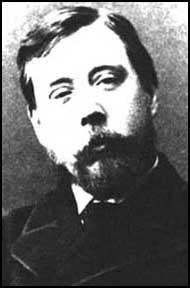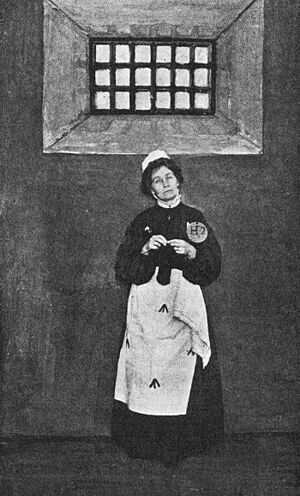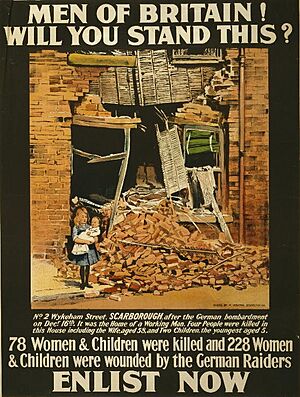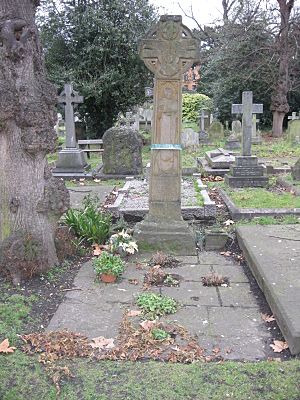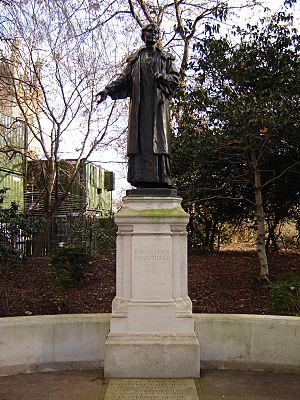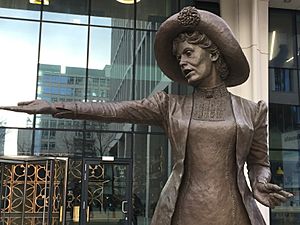Emmeline Pankhurst facts for kids
Quick facts for kids
Emmeline Pankhurst
|
|
|---|---|

Pankhurst, c. 1913
|
|
| Born |
Emmeline Goulden
15 July 1858 Manchester, England
|
| Died | 14 June 1928 (aged 69) Hampstead, London, England
|
| Monuments | Statue of Emmeline Pankhurst Emmeline and Christabel Pankhurst Memorial |
| Occupation | Political activist and suffragette |
| Political party | Women's Party (1917–1919) Conservative Party (1926–1928) |
| Movement | Women's Social and Political Union |
| Spouse(s) |
Richard Pankhurst
(m. 1879; died 1898) |
| Children | 5, including Christabel, Sylvia, and Adela Pankhurst |
| Parent(s) | Sophia Goulden (mother) |
| Relatives | Mary Jane Clarke (sister) Richard Pankhurst (grandson) Helen Pankhurst (great-granddaughter) Alula Pankhurst (great-grandson) |
Emmeline Pankhurst (born Goulden; 15 July 1858 – 14 June 1928) was a British political activist. She led the suffragette movement in the UK. Her work helped women win the right to vote.
In 1999, Time magazine called her one of the 100 Most Important People of the 20th Century. They said she "shook society into a new pattern." People often criticized her strong methods. However, her efforts are seen as key to women getting the vote in the United Kingdom.
Emmeline was born in Moss Side, Manchester. Her parents were very involved in politics. At age 14, she learned about the women's right to vote movement. She later helped start the Women's Franchise League. This group fought for all women, married or single, to have the right to vote.
She also tried to join the Independent Labour Party. But they first said no because she was a woman. While working as a Poor Law Guardian, she saw how hard life was in Manchester's workhouses. This experience deeply affected her.
In 1903, Pankhurst started the Women's Social and Political Union (WSPU). This group was only for women. Their motto was "deeds, not words." They wanted to win the vote through action. The WSPU was known for its bold protests. Members sometimes broke windows and argued with police.
Pankhurst, her daughters, and other WSPU members were often sent to prison. There, they went on hunger strikes to get better conditions. They were sometimes force-fed. As her oldest daughter Christabel took a bigger role, the group's actions became even stronger. They even used arson (setting fires) as a tactic. Some people and groups disagreed with these methods.
When the First World War began, Emmeline and Christabel stopped their protests. They believed that Germany was a threat to everyone. They wanted to support the British government during the war. Emmeline led a large march called the Women's Right to Serve demonstration. This showed how women were helping the war effort. They encouraged women to work in factories and young men to join the army.
In 1918, the Representation of the People Act was passed. This law gave all men over 21 the right to vote. It also gave women over 30 the right to vote. The age difference was to make sure men were not a minority of voters after many died in the war.
After the war, Emmeline changed the WSPU into the Women's Party. This party worked for women's equality in public life. Later in her life, she worried about Bolshevism (communism). She joined the Conservative Party in 1926. She was chosen to run for Parliament in 1927.
Emmeline Pankhurst died on 14 June 1928. This was just weeks before the Representation of the People (Equal Franchise) Act 1928 was passed. This new law gave all women over 21 the right to vote. Two years later, a statue of her was put up in Victoria Tower Gardens in London.
Contents
Early Life and Political Awakening

Emmeline Goulden was born on 15 July 1858, in Moss Side, Manchester. At school, her teachers called her Emily, which she liked. She believed her birthday was actually on 14 July, Bastille Day. She felt a connection to the French revolutionaries who stormed the Bastille. She said this date had "some kind of influence over my life."
Her family had a long history of political action. Her mother, Sophia Goulden, came from the Isle of Man. In 1881, the Isle of Man was the first country to let women vote in national elections. Her father, Robert Goulden, was a successful businessman. He was active in local politics and supported social causes.
The Gouldens had 10 children, and Emmeline was the oldest of five daughters. Her father loved theatre and drama. Emmeline learned to appreciate these things from him. She later used this skill in her activism. Her parents also taught their children about social justice. For example, they welcomed American abolitionist Henry Ward Beecher to their home. Emmeline remembered collecting money for newly freed slaves when she was young.
Emmeline loved to read from a very young age. She read the Odyssey at nine. She also enjoyed The Pilgrim's Progress and The French Revolution: A History. She said this last book was "all [her] life a source of inspiration." However, her parents believed girls should learn skills for marriage. They did not give their daughters the same education as their sons.
Emmeline first learned about women's suffrage through her parents. Her mother read the Women's Suffrage Journal. Emmeline admired its editor, Lydia Becker. At 14, Emmeline went to a meeting where Becker was speaking. She was so inspired that she "left the meeting a conscious and confirmed suffragist."
A year later, she went to school in Paris. The school taught girls chemistry and bookkeeping, along with traditional arts. Her roommate was Noémie, whose father was a political prisoner. The girls shared stories of their parents' political lives.
Marriage and Early Activism
In 1878, Emmeline, then 20, met Richard Pankhurst. He was a lawyer who had supported women's right to vote for years. He was 44. They fell in love and married on 18 December 1879.
During the 1880s, Emmeline Pankhurst raised her children. But she also stayed active in politics. She and Richard believed she should not just be a "household machine." They hired help so she could work with the Women's Suffrage Society. Their first daughter, Christabel, was born in 1880. Then came Estelle Sylvia in 1882, and their son Frank in 1884.
In 1885, their daughter Adela was born. The family moved to London. Richard ran for Parliament but did not win. Emmeline opened a fabric shop with her sister.
In 1888, Emmeline's son Frank died from diphtheria. She was heartbroken. The family believed poor drainage caused his illness. They moved to a nicer area. Emmeline had another son in 1889, named Henry Francis.
Their home in London became a meeting place for political thinkers. Socialists, suffragists, and other activists gathered there. Emmeline enjoyed decorating the house. She also dressed her family in nice clothes. Her daughter Sylvia later wrote that beauty was important to her mother's public work.
Women's Franchise League
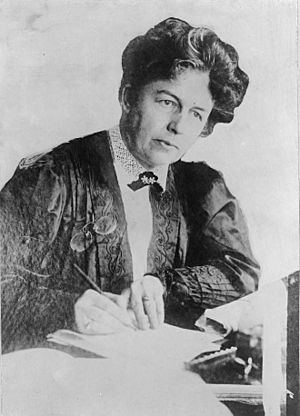
In 1888, a large group fighting for women's votes, the National Society for Women's Suffrage (NSWS), split up. Emmeline Pankhurst joined the group that wanted to work with political parties. However, this group was slow to support married women's voting rights. Many thought husbands voted for their wives.
So, Emmeline and Richard helped start a new group. It was called the Women's Franchise League (WFL). Its first meeting was at their home in 1889. The WFL was seen as a radical group. It supported voting rights for all women, married or unmarried. It also fought for equal rights in divorce and inheritance. The WFL also wanted to work with socialist groups. This radical approach caused some members to leave. The group eventually ended a year later.
Working with the Independent Labour Party
Emmeline's shop in London did not do well. The family moved back to Manchester in 1893. Emmeline began to work with several political groups. She became known as an activist in her own right. She joined the Women's Liberal Federation (WLF). But she soon became unhappy with their slow approach.
In 1888, Pankhurst met Keir Hardie, a socialist from Scotland. He helped create the Independent Labour Party (ILP) in 1893. Emmeline was excited about the ILP's goals. She left the WLF and joined the ILP. Her daughter Christabel later wrote that her mother hoped this party could fix "every political and social wrong."
One of her first jobs with the ILP was giving food to poor people. In 1894, she was elected as a Poor Law Guardian. This meant she helped manage workhouses. She was shocked by the terrible conditions there. She quickly worked to improve things. She became a strong voice for reform on the Board.
In 1898, Emmeline's husband, Richard, died suddenly. This left her with many new responsibilities and debts. She moved her family to a smaller house. She took a paid job as a Registrar of Births and Deaths. This work showed her more about the hard lives of women in the area. She wrote that women told her "dreadful stories." She saw how different men's and women's lives were. This made her even more sure that women needed the right to vote to improve their lives. In 1900, she was elected to the Manchester School Board. She saw more examples of women facing unequal treatment.
Founding the WSPU: "Deeds, Not Words"
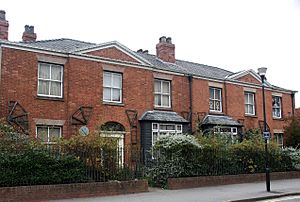
By 1903, Emmeline Pankhurst felt that years of talking and promises about women's suffrage had led nowhere. Bills to give women the vote had failed many times. She believed that political parties would never make women's suffrage a top priority. She even left the ILP because it wouldn't focus on "Votes for Women."
She decided that patient methods were not working. Stronger actions were needed. So, on 10 October 1903, Pankhurst and some friends started the Women's Social and Political Union (WSPU). This group was only for women. It focused on direct action to win the vote. Emmeline later wrote, "Deeds, not words, was to be our permanent motto."
At first, the WSPU's actions were not violent. They gave speeches, collected signatures, and held rallies. They also published a newsletter called Votes for Women. They held "Women's Parliaments" to match official government meetings. In 1905, when a suffrage bill failed, Pankhurst and WSPU members protested loudly outside Parliament. Police moved them away, but they kept demanding the bill's passage. Pankhurst saw this as a success. She said in 1906, "We are at last recognized as a political party."
Soon, all three of her daughters joined the WSPU. Christabel was arrested in 1905. Adela and Sylvia were arrested in 1906. Emmeline Pankhurst was arrested for the first time in February 1908. She tried to enter Parliament to give a protest message to the Prime Minister. She was charged with blocking the way and sent to prison for six weeks. She spoke out against the prison conditions. Pankhurst saw being in prison as a way to show how urgent women's suffrage was. She was arrested seven times before women got the vote. In court, she said, "We are here not because we are law-breakers; we are here in our efforts to become law-makers."
The WSPU focused only on votes for women. They did not work with political parties that did not make women's suffrage a priority. This often put them against the Liberal Party. Members of the WSPU were sometimes booed for causing Liberal candidates to lose elections. Pankhurst and others in the WSPU believed party politics distracted from their goal.
As the WSPU grew, Pankhurst kept control of the group. In 1907, some members wanted more say in decisions. Pankhurst changed the rules so that a small committee, chosen by her, would lead the WSPU. This caused some members to leave and form their own group.
Stronger Tactics and Hunger Strikes
In June 1908, 500,000 activists gathered in Hyde Park to demand votes for women. But the Prime Minister did not listen. This made some WSPU members take stronger actions. Two members, Edith New and Mary Leigh, threw rocks at the Prime Minister's home. Pankhurst approved of their actions. She reminded the court that men had broken windows in the past to win rights.
In 1909, the hunger strike became a new WSPU tactic. Marion Wallace Dunlop was arrested for writing on a wall in the House of Commons. She went on a hunger strike to protest jail conditions. Many other WSPU members followed her example. Prison officials often force-fed the women. This was done using tubes through the nose or mouth. These painful methods were criticized by many.
These tactics caused problems with more moderate groups. The National Union of Women's Suffrage Societies (NUWSS) at first praised the WSPU. But by 1912, their leader, Millicent Fawcett, said hunger strikes were just for publicity. She called militant activists "the chief obstacles" to the suffrage movement. The NUWSS refused to join marches with the WSPU if they continued property damage.
Newspapers had mixed reactions. Many noted that crowds liked Pankhurst's speeches. Others criticized her strong methods. In 1906, a journalist called militant women "suffragettes" instead of "suffragists." Pankhurst and her allies adopted the term to show they were different from the moderate groups.
The years around 1910 were hard for Pankhurst. She sold her home and traveled constantly, giving speeches. She was energized by the fight, but it meant being away from her children. In 1909, her son Henry became very ill. She went on a speaking tour in the United States to earn money for his treatment. Henry died in January 1910. Five days later, she spoke to 5,000 people in Manchester.
Conciliation, Arrests, and Arson
After elections in 1910, a group of MPs tried to pass a "Conciliation Bill" for women's suffrage. The WSPU agreed to stop protests while this was discussed. But when the bill failed, Pankhurst said the truce was over. She led a protest of 300 women to Parliament Square. Police responded aggressively. This day became known as Black Friday. Her sister, Mary Jane, was arrested and died soon after her release.

In March 1912, Pankhurst joined a new wave of window-smashing. Police raided WSPU offices. Pankhurst and Emmeline Pethick-Lawrence were found guilty of planning property damage. Christabel, who was leading the WSPU, fled to Paris. In prison, Emmeline Pankhurst went on hunger strike to improve conditions for other suffragettes.
Pankhurst continued to break the law and starve herself in prison. She was arrested many times but often released quickly due to her poor health. The government passed the Cat and Mouse Act. This allowed sick suffragettes to be released, then re-arrested when they recovered. Police tried to arrest her during speeches and marches. The WSPU formed a bodyguard squad trained in jujutsu to protect her.
In 1912, WSPU members started using arson (setting fires) as a tactic. Women set fire to buildings, post boxes, and railway carriages. In 1913, Emily Davison died after running in front of the King's horse at the Epsom Derby. Her funeral brought huge publicity to the movement. Pankhurst supported these actions, even if she didn't directly order them. Other suffragettes used acid to burn "Votes for Women" into golf courses. In 1914, Mary Richardson slashed a famous painting to protest Pankhurst's imprisonment.
These strong tactics caused some members to leave the WSPU. Emmeline Pethick-Lawrence and her husband were expelled. Emmeline's daughter Adela also left. She disagreed with the property destruction and wanted more focus on socialism.
The biggest family split happened in 1913. Sylvia Pankhurst was working with a WSPU branch that was close to socialists. Christabel believed Sylvia was trying to challenge the WSPU. Emmeline and Christabel told Sylvia to separate her group from the WSPU. Emmeline also sent Adela to Australia, and they never saw each other again.
First World War and Women's Suffrage Achieved
When the First World War started in August 1914, Emmeline and Christabel believed Germany was a threat to everyone. They thought the British government needed full support. They convinced the WSPU to stop all protests for suffrage until the war ended. Christabel said, "This was national militancy." A truce was made with the government. All WSPU prisoners were released, and Christabel returned to London.
Emmeline and Christabel used the WSPU to support the war effort. Christabel warned of the "German Peril." She urged women to help keep the country running while men fought. Emmeline tried to encourage men to join the army.
Sylvia and Adela did not agree with their mother's support for the war. They were pacifists. Sylvia believed the war was about rich people using poor soldiers. Adela spoke against the war in Australia. Emmeline was very disappointed in them. She also had no patience for anyone in the WSPU who disagreed with supporting the government.
Pankhurst put all her energy into supporting the war. She held rallies and gave speeches. She pushed the government to help women get jobs while men were fighting. She also worried about "war babies," children born to single mothers whose fathers were at war. She opened a home for these children. Some people criticized her for helping children born outside of marriage. But she said children's welfare was her only concern. She even adopted four children herself.
Trip to Russia
In 1916, Pankhurst visited North America. She raised money and urged the US government to support Britain in the war. In 1917, she returned to the US. She encouraged American suffragettes to support the war effort too. She also spoke about her fears of communism in Russia.
By June 1917, the Russian Revolution was growing stronger. The Bolsheviks wanted to end the war. Pankhurst went to Russia in June. She hoped to convince the Russian people not to make peace with Germany. She told a crowd, "I came to Petrograd with a prayer from the English nation to the Russian nation, that you may continue the war."
In August, she met with Alexander Kerensky, the Russian Prime Minister. She had become very against leftist politics. The meeting was difficult. She later called him the "biggest fraud of modern times."
The Vote is Won!
When she returned from Russia, Pankhurst was thrilled. Women's right to vote was finally happening. The 1918 Representation of the People Act gave all men over 21 the right to vote. It also gave women over 30 the right to vote, with some rules.
As suffragists celebrated, a new question came up: Should women's political groups join with men's groups? Emmeline and Christabel Pankhurst believed women should stay separate. They changed the WSPU into the Women's Party, still only for women. They believed women could "best serve the nation by keeping clear of men's party political machinery." The party wanted equal marriage laws, equal pay, and equal job chances for women.
Later Life and Legacy
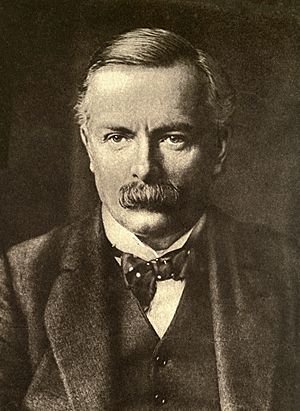
After the war ended in 1918, Pankhurst continued to promote British unity. She still focused on women's empowerment. She defended the British Empire. She said it was "a great thing to be the inheritors of an Empire like ours." For years, she traveled, supporting the British Empire and warning about communism. She lived in Bermuda and America for a few years.
Emmeline Pankhurst also became active in politics again. A new law allowed women to run for the House of Commons. Many in the Women's Party wanted her to run. But she thought Christabel was a better choice. She worked hard for her daughter's campaign. Christabel lost by a small number of votes. This was a great disappointment for Emmeline. The Women's Party soon ended.
Pankhurst liked Canada, saying there was "more equality between men and women" there. In 1922, she moved to Toronto with her four adopted children. She gave speeches promoting "race betterment," a eugenic idea. She also asked why there were homes for "fallen women" but not for "fallen men." However, she found Canadian winters too long and ran out of money. She returned to England in 1925.
Back in London, Sylvia visited her mother. Their political views were very different now. Emmeline's adopted daughter remembered Emmeline leaving the room in tears. Christabel had become very religious. The British press sometimes joked about how different the once close family had become.
In 1926, Pankhurst joined the Conservative Party. Two years later, she ran for Parliament in Whitechapel and St George's. Many people were surprised by her change from a radical activist to a Conservative. She said her war experiences and time in America changed her views. She was dedicated to women's empowerment and fighting communism.
Illness and Death
Emmeline Pankhurst's campaign for Parliament was cut short by her poor health. She moved into a nursing home in Hampstead. She died on 14 June 1928, at age 69. She was buried in Brompton Cemetery in London.
Legacy and Recognition
News of Emmeline Pankhurst's death spread across the country and North America. Her funeral on 18 June 1928 was attended by former WSPU members. The Daily Mail called the procession "like a dead general in the midst of a mourning army." Women wore WSPU sashes. Christabel and Sylvia attended together. Adela did not. Newspapers around the world recognized her tireless work for women's right to vote. The New York Herald Tribune called her "the most remarkable political and social agitator of the early part of the twentieth century."
Soon after the funeral, a former WSPU bodyguard, Catherine Marshall, raised money for a statue. In March 1930, her statue was unveiled in Victoria Tower Gardens, near the Houses of Parliament. Former Prime Minister Stanley Baldwin presented the memorial. He said, "Mrs. Pankhurst has won for herself a niche in the Temple of Fame which will last for all time." Sylvia was the only Pankhurst daughter there.
Historians still debate whether Emmeline Pankhurst's strong methods helped or hurt the movement. However, most agree that the WSPU made the public much more aware of the movement. This was very important. Pankhurst helped pave the way for future feminists.
In 1987, one of her homes in Manchester opened as the Pankhurst Centre. It is a museum and gathering space for women. In 2002, Pankhurst was ranked number 27 in the BBC's poll of the 100 Greatest Britons. In 2006, a blue plaque was placed at 50 Clarendon Road, London, where she and Christabel lived.
In 2016, a new statue of Emmeline Pankhurst was announced for Manchester. It was unveiled on 14 December 2018. This was 100 years after British women first voted in the 1918 United Kingdom general election. Her name and image are also on the plinth of the statue of Millicent Fawcett in Parliament Square, London.
Helen Pankhurst, Emmeline's great-granddaughter, works for women's rights today. She co-founded Olympic Suffragettes.
Emmeline Pankhurst has appeared in popular culture. Siân Phillips played her in the 1974 TV series Shoulder to Shoulder. Meryl Streep played her in the 2015 film Suffragette.
See also
 In Spanish: Emmeline Pankhurst para niños
In Spanish: Emmeline Pankhurst para niños


